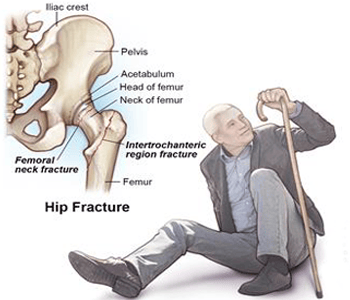The Best Clinical Talent And Skills
What is a Fracture of the hip?
A hip fracture occurs when the upper pelvis is injured, which can be the femoral head, femoral neck, or trochanter.
What is the most common location for hip fractures?
- The most common site through hip fracture is the femoral neck.
- Women are more at risk than Men
- Chances increase for over age 60 patients due to osteoporosis
- Other common sites of femoral fracture are the femoral head and trochanter.
- Femoral head fractures are typically caused by a dislocated femur that pulls the femur out of the acetabular socket.
- These injuries usually occur as a result of high-impact car accidents.
- These fractures are also common for people with osteoporotic fractures–stress fractures or abnormal fractures

Types of hip fractures?
There are three main types of hip fractures:
Displaced Fracture. The fracture is displaced when separated into two or more pieces that don’t remain in place.
Nondisplaced Fracture. The fracture is nondisplaced when the pieces of broken bone don’t separate.
Stress or Insufficiency Fracture. The fracture is limited to a tiny crack or cracks in the bone.
What Are the Symptoms of a Hip Fracture?
Symptoms of a hip fracture encompass large, sharp pain within the hip or groin and swelling, bruising, and tenderness within the skin on the site of the harm. Depending on the severity of the fracture, a broken bone can also save you from placing any weight on the affected hip.
Who Is At A Higher Risk for Hip Fractures?
- People older than age 60 due to falls.
- Postmenopausal ladies who've osteoporosis are at risk.
- Repeated high-impact exercise in athletes may also result in a strain fracture, which is a small crack in the hip or pelvic bone.
How Hip Fractures Are Diagnosed?
Physical Exam
A health practitioner examines your hip and pelvis to evaluate the quantity of swelling, bruising, and tenderness. He or she asks about the region and severity of the pain you’re experiencing
Diagnostic Imaging
X-rays X-ray images show the location of a fractured bone in the hip or pelvis using electromagnetic radiation. They additionally help your medical doctor determine if a bone is damaged in multiple places and whether any bone fragments had been displaced, or moved out of position.
CT Scans Your medical doctor can also order a CT experiment to take a look at a fracture pattern or investigate the quantity of damage inside the hip joint. The two- and three-dimensional pictures of the hip and pelvic bones, permit docs to have a look at a fracture from many distinctive angles. This check may additionally screen the presence of small bone fragments, which might also end up lodged in the hip joint and require surgical elimination.
MRI scans Your doctor may recommend an MRI if the doctor suspects a stress fracture of the hip or pelvis that cannot be seen on an X-ray, or if symptoms indicate damage to muscles, tendons, blood vessels, or nerves in addition to the fracture.
Bone Scan If you have pain and swelling that indicate a fracture but you can’t get an MRI because you have a pacemaker or other implanted medical device, your doctor may recommend a bone scan
Treatment
Non-surgical treatment – These are often recommended when a fractured hip or vertebrae is immobilized, which means the bone fragments are still in place. For that matter, your doctor may recommend one of the following.
Activity Modification -You will need to change your activities so that you do not put any weight on the affected hip for 6 weeks or more so that the bone can heal. You can use a cane, walker, cane, or wheelchair to help you move around during this time.
Electronic and Ultrasonic Bone Stimulation. - This type of bone stimulation helps speed up bone healing, using low-frequency electrical pulses or low-fre quency sound waves to stimulate your body to produce proteins that begin to repair cells at the site of injury
Can be done in the center or at HOME.
Physical Therapy - Once you begin treatment for a hip or spine injury, a physical therapist will work with you to teach you exercises to help preserve movement and general strength in the joints and muscles surrounding the injury.
Pain Medication - You may be prescribed pain medication for the first 1 – 2 weeks after your injury, and then you would go to therapy to help relieve the pain.
Surgical treatment - Surgery is common for hip fractures. Surgery is often performed to reduce fractures, stabilize bones, and repair soft tissue. The following procedures are generally recommended to ensure complete healing and prevent joint damage.
Hip replacement surgery - Hip replacement surgery is generally recommended for patients with
1) A large hip fracture in which reduction and fixation destabilize the bone, or
2) A tumor that significantly affects hip function. Depending on where the extent of the injury, the patients may have a partial or total hip replacement.
When is recovery after hip fractures?
A broken hip usually takes months to heal. If you have a hip fracture, you may end up in a hospital or rehabilitation center until you can walk properly again. After hip surgery, you will need physical therapy. These exercises will help strengthen your hips and help you get back in shape.
Orthopaedics, Dr. Ashish Dagar and Dr. Lokesh Garg is counted among one of the most famed & experienced HIP Fracture Surgery Doctors in Gurgaon. Best HIP Fracture Treatment Hospital in Gurgaon Sector 52, 90, led by HIP Fracture surgery specialist Gurgaon.

